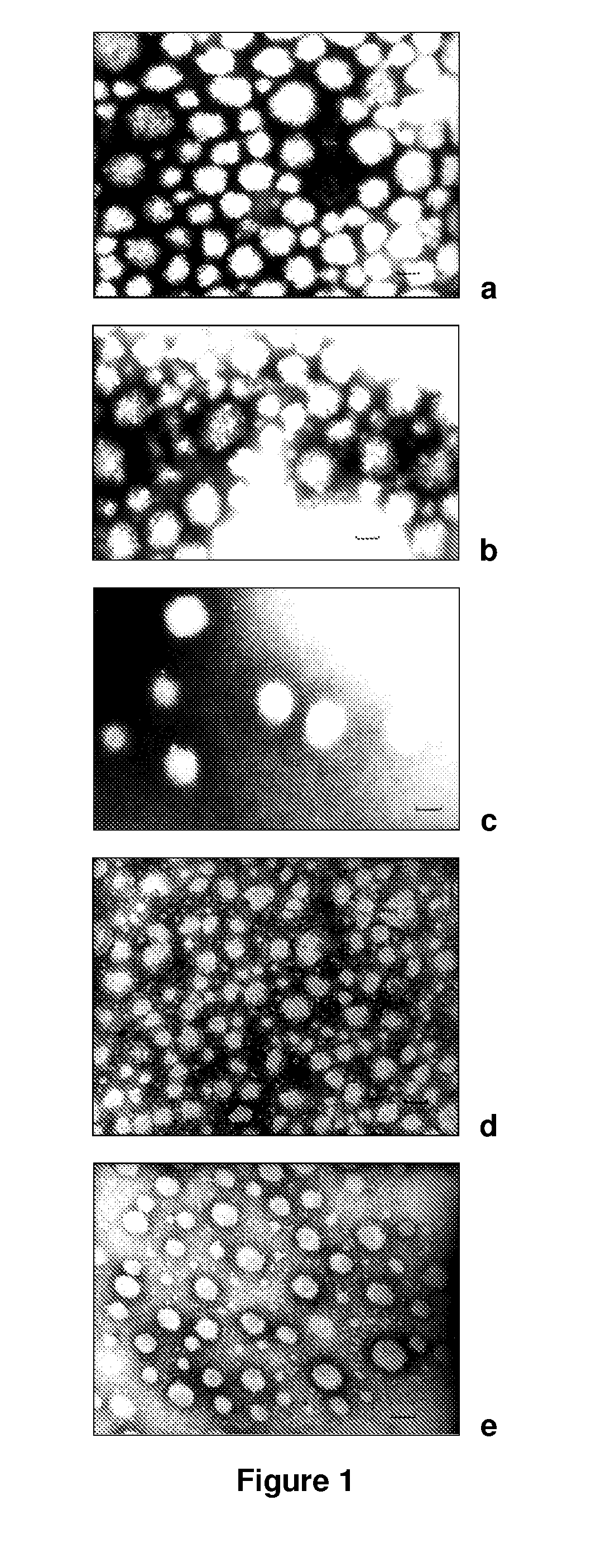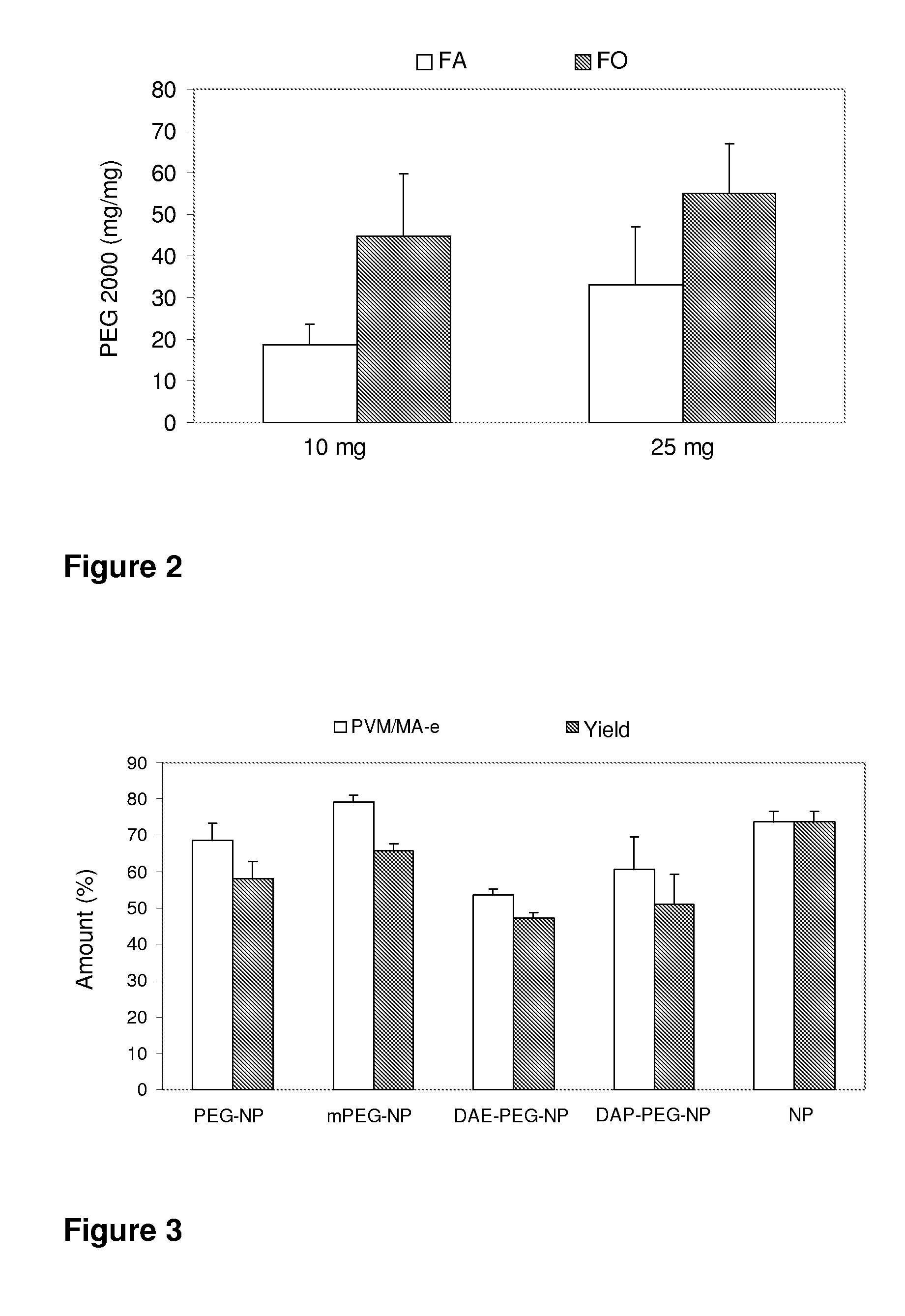Pegylated Nanoparticles
a technology of pegylated nanoparticles and nanoparticles, which is applied in the direction of nanocapsules, microcapsules, capsule delivery, etc., can solve the problems of low intestinal absorption degree, certain instability in gastrointestinal fluids, and non-specific tropism or adhesion in the gastrointestinal mucosa
- Summary
- Abstract
- Description
- Claims
- Application Information
AI Technical Summary
Benefits of technology
Problems solved by technology
Method used
Image
Examples
example 1
[0096]Preparing Pegylated Nanoparticles with Polyethylene Glycol 2000 (PEG-NP)
[0097]Two processes have been tested:
[0098]mixing the two polymers in the organic phase
[0099]coating the pre-formed nanoparticles with PEG
[0100]The yields of the process for manufacturing the pegylated nanoparticles are obtained by means of determining their weight at the end of the process and after their lyophilization. The manufacturing yields are expressed in percentages, calculated with respect to the initial mass of the PVM / MA-copolymer and of polyethylene glycol. The amount of polyethylene glycol associated to the nanoparticles is determined by colorimetry (Labsystems iEMS Reader MF), and is calculated as a difference between the initial amount used and the amount found in the supernatants obtained during the preparation of nanoparticles.
1.1. Association of Polyethylene Glycol to Vinyl Methyl Ether and Maleic Anhydride Copolymer in the Organic Phase
[0101]This process is carried out by simultaneous i...
example 2
[0110]Preparing Pegylated Nanoparticles with Polyethylene Glycol Methyl Ether 2000 (mPEG-NP)
[0111]This process is carried out by simultaneous incubation of PVM / MA and mPEG in an organic phase.
[0112]To that end, 100 mg of the copolymer PVM / MA are dissolved in 5 ml of organic solvent (acetone). Then, an amount of mPEG 2000 is added to this solution (10-50 mg). The mixture is left to react with magnetic stirring for 1 hour. Then, 10 ml of ethanol and 10 ml of distilled water are added to this phase. The resulting mixture is left to homogenize for 5 minutes. The organic solvents are removed by evaporation under reduced pressure (Buchi R-144, Switzerland), concentrating the nanoparticle suspension. The suspension is subjected to purification by centrifugation (20 minutes at 17000 rpm, twice) (Sigma 3K30, Germany). The supernatants are removed and the residue is resuspended in a sucrose aqueous solution (5% w / v). The nanoparticle suspension is finally frozen and lyophilized in a Genesis 1...
example 3
[0115]Preparing Pegylated Nanoparticles with O,O′-Bis-(2-Aminoethyl) Polyethylene Glycol 2000 (DAE-PEG-NP)
[0116]This process is carried out by simultaneous incubation of PVM / MA and DAE-PEG 2000 in an organic phase.
[0117]To that end, a certain amount of DAE-PEG (5, 10, 25 or 35 mg) is dissolved in 5 ml of organic solvent (acetone). Then 100 mg of PVM / MA are added to this solution with magnetic stirring. The resulting mixture is left to react with magnetic stirring for 1 hour. 10 ml of ethanol and 10 ml of distilled water are added to this organic phase with stirring. The resulting mixture is left to homogenize for 5 minutes. The organic solvents are removed by evaporation under reduced pressure (Buchi R-144, Switzerland), concentrating the nanoparticle suspension. The suspension is subjected to purification by centrifugation (20 minutes at 17000 rpm, twice) (Sigma 3K30, Germany). The supernatants are removed and the residue is resuspended in a sucrose aqueous solution (5% w / v). The n...
PUM
| Property | Measurement | Unit |
|---|---|---|
| molecular weight | aaaaa | aaaaa |
| molecular weight | aaaaa | aaaaa |
| weight ratio | aaaaa | aaaaa |
Abstract
Description
Claims
Application Information
 Login to View More
Login to View More - R&D
- Intellectual Property
- Life Sciences
- Materials
- Tech Scout
- Unparalleled Data Quality
- Higher Quality Content
- 60% Fewer Hallucinations
Browse by: Latest US Patents, China's latest patents, Technical Efficacy Thesaurus, Application Domain, Technology Topic, Popular Technical Reports.
© 2025 PatSnap. All rights reserved.Legal|Privacy policy|Modern Slavery Act Transparency Statement|Sitemap|About US| Contact US: help@patsnap.com



